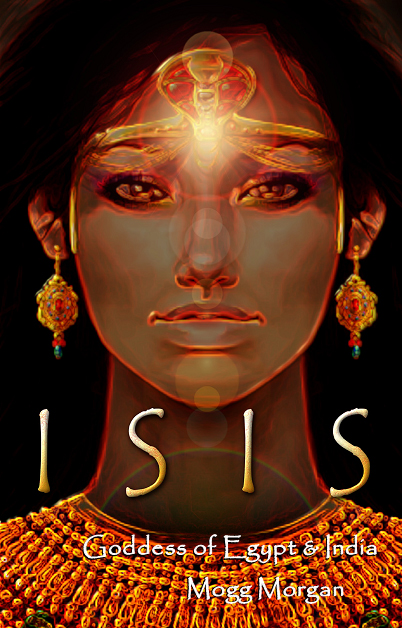
Isis, Goddess of Egypt & India
Mogg Morgan
ISBN: 978-1-906958-71-8,
£17.00/$26.00
– A Temple of Isis in India –
On India’s, south-western or Malabar coast is situated an ancient Hindu temple which is these days devoted to the famous Hindu god Shiva and his consort the fearsome goddess Kali. This is Kurumbha-Bhagavathy Devi outside of the modern city of Cochin or Kochi in Kerala state.
Travel back in time and the temple housed other gods. Once it was the home of the Buddhist/Jaina goddess Pattini whose mortal husband was tried and killed in a series of brutal events still commemorated in the temple’s ritual year. Before this and the story gets even stranger, as there are said to be remains of a secret, underground shrine, the home to a mystery cult dedicated to the Egyptian goddess Isis.
At the time of Christ, there was indeed a Greco-Roman merchant colony based in this part of India. Greek, Roman & Near Eastern merchants travelled to India after a regular, if epic, sea journey of two thousand miles across the Arabian Ocean, making their first landfall at a port known in the ancient world as Musiris. Clues to the religious practices of these ancient traders is evident not just in the surviving architecture but in very many, sometimes unique features of the later cults, continuing into the modern-day.
Some of the best examples come from the rites of Pattini as once practised at Kurumba-Bhagavathy Devi. Experts have often identified the story of her husband’s death and resurrection, as something of the Near Eastern cult of Attis. But a more recent and credible theory is that the temple once hosted the mysteries of the cult of Isis, whose husband Osiris was also cruelly cut down but then resurrected by her magical prowess.
So without more ado let me tell the whole story from its beginnings on the banks of the Nile. The story of Isis and Osiris is the basis of Egypt’s most popular religion. In what follows I trace the origins of this to Egypt’s pyramid age in the middle of the second millennia BCE. Arguably it is even older. A great deal of this books is devoted to describing what is known about the cult of Isis and Osiris from Egyptian records. This, I shall argue, is the basis for what comes later in the timeline, when the world was dominated by the Greek and Roman Empires. Isis and Osiris became the focus of global religion and the basis of the most popular of all classical mystery cults. This is precisely the time at which a small, Near Eastern shrine was built in South-West India to service the needs of the merchant trading post. Mysteries of Isis were popular among all social classes in the ancient world, especially mariners.
In India, we have a building which could itself be thought of as storing the memory of influences from each new wave of belief. We can follow the progress and transformation of its changing occupants, as each absorbs some of the archaeological memory. Finally, we arrive at its current incarnation and the celebration of the Bharani festival, which marks the beginning of the hot summer before the coming of the Monsoon rains. Many non-orthodox rites will enliven the tale. The mysterious society of Atikals returns to their lost temple every year to conduct secret rites culminating in twelve hours of ‘Misrule’, during which hundreds of thousands of devotees appear from all over Kerala.
There are other devotees who carry sticks, which they swirl in their dancing; others brandish the sickle sword. Most of these pilgrims are non-Brahmin ritual specialists such as the Veliccappadu. Their name means “a channel who sheds light” for they are spirit mediums, men and women, followers of Kali who utter oracles when in trance. They dress in red and wear heavy anklets and bells.
In the final part of my story, I present a complete and ‘lost’ version of the most famous drama of all time, the celebrated myth of passion play of Isis and murdered husband Osiris, clearly recognizable even in its current idiom based as it is in South Asian ritual drama. The drama is reproduced in its entirety as it reveals many previously unknown aspects of one of the world’s oldest myths.

 Tantra for Westerners
Tantra for Westerners